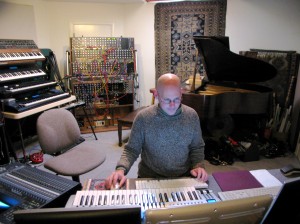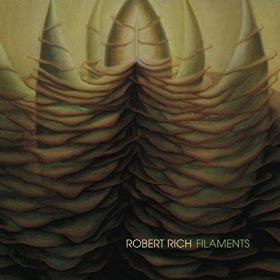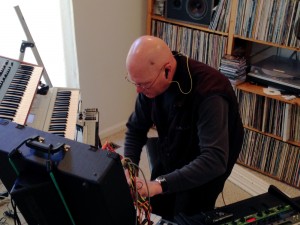The Sound of Deep Space & Deep Time with Robert Rich
Podcast: Play in new window | Download
Subscribe: RSS
 Hear Robert Rich’s interview above or download the podcast from iTunes.
Hear Robert Rich’s interview above or download the podcast from iTunes.
Over the course of the last 35 years, Robert Rich has created one of the most stylistically diverse and artistically centered catalogues of almost any electronic artist. From 7-hour Drone Zone expanses to driving sensually percussive melodies to a style that he calls “glurp,” they are all centered by one of the more thoughtful and cerebral aesthetics in music. Earlier this year, Rich released his album, Filaments.
When Robert Rich creates an album, his concepts are rarely simple. Take a couple of his earlier recordings, Gaudi and Geometry.
“Gaudi perhaps was a little bit of an experiment in in architecture. Geometry was more algorithmic, mathematical and the other half is more grounded,” explained Robert Rich.
Robert Rich’s latest album, Filaments, finds the veteran composer exploring further themes of science, psychology and the spirit.
“Well, it’s dealing mostly with my sense of awe and wonder at our ability to ask questions about the unseen,” expressed Rich. “Deep time, deep space, cosmology, and for me, gluing it together with the idea of the anthropic principle, which in a nutshell says that for some reason, this universe allows consciousness to exist because we’re here, so then how–we can start asking what is it about the conditions of space and time that allow us to exist. And now the seeking other planets and other life is getting so far along, we might find it in our lifetime,” said Rich.
On Filaments, that manifests in a few ways. One is the composition titles which are drawn from physics, like “Majorana.”
 “Majorana”, it’s the name of an Italian physicist who theorized the kind of fermion, which is its own anti-particle, so something which is particle and its own anti-particle” says Rich. “Turns out it might help us explain what dark matter is.” Particles and anti-particles, that’s something in which only Robert Rich could find inspiration for music, but I think you might understand what he’s talking about when you hear the piece.
“Majorana”, it’s the name of an Italian physicist who theorized the kind of fermion, which is its own anti-particle, so something which is particle and its own anti-particle” says Rich. “Turns out it might help us explain what dark matter is.” Particles and anti-particles, that’s something in which only Robert Rich could find inspiration for music, but I think you might understand what he’s talking about when you hear the piece.
If you want to central casting for an intense, intellectual actor you couldn’t do better than Robert Rich. Slender with a shaved head and wire-rimmed glasses, all you need is a white lab coat to make him look like the prototypical Poindexter as he leans across his synthesizers. Born in 1963, Robert Rich initially thought science was his path.
“I studied physics and engineering when I was a freshman in college, and then I discovered that I really liked psychophysiology and that fit my brain more,” confirmed Rich.
Rich was already interested in early minimalist composers and heard the psychedelic, mind-altering effects of their music.
“Minimalists, Terry Riley and Lamont Young, try to use music as a psychoactive trigger” enthuses Rich “Many of my albums skirt around that very fond feeling I have for Terry’s music. And there’s a certain complex emotion that he somehow pulls out, this mix of joy, and wonder, and mystery and calmness. It’s a feeling that I think comes from seeking for an emotion that doesn’t have a name, that sort of ecstatic feeling.”
At the same time, Rich was hearing the space journeys of German electronic artists like Tangerine Dream and Klaus Schulze.
“It knocked me sideways when I first heard Rubycon and Stratosfear back in the mid ‘70s. I was like in eighth grade and it was–I was already into Vangelis and things like that, so it wasn’t the first electronic music I heard. But I think what I ended up finding more inspiration from were groups like Cluster and Popol Vuh,” Rich recalled, citing a couple of even lesser known bands with sounds that are quirky (Cluster) and spiritual (Popol Vuh.)
 One of the lesser-known influences on Rich was a 1972 album called The Wind Harp: Songs From the Hill. It was a recording of the wind blowing through a 30 foot tall Aeolian harp on a Vermont hilltop.
One of the lesser-known influences on Rich was a 1972 album called The Wind Harp: Songs From the Hill. It was a recording of the wind blowing through a 30 foot tall Aeolian harp on a Vermont hilltop.
“When I was about 11-12 years old, I found an album in the cutout bin at Woolworth called Wind Harp Song from the Hill,” recalls Rich. “And I remember putting that on and it sounded like the music in my head. It was the music that I heard when I closed my eyes and I would fly on an out of body experience. I was a weird kid,” remembered Rich.
All of these experiences led Robert Rich to move from being a scientist, to being musician with a scientific mind.
“I had the sense that the only thing that I was capable of doing with my introverted personality was to try to find ways of being a 21st century shaman, and to guide people through experiences that would show them new kinds of beauty or understanding that actually made sense in a modern world,” said Rich.
That’s a lot to put on your back, but Robert Rich has been doing it for 35 years. Most musicians talk about the cosmos and questions of existence in broad and abstract terms, like when Yes’ “mountains come out of the sky and stand there.” It’s often just dressing that’s hung on their music as metaphorical context. But Robert Rich’s music actually explores things like the relationship of nucleotide sequences.
“If you take that piece “Telomere”, you know, about DNA, and you realize it’s about timing,” he says, as if explaining the obvious. “it’s about clocks, and so there’s one element, this sort of heartbeat rhythm that actually permeates the whole album. And just limiting it right down to a pulse and that pulse is like the heartbeat. And that’s our human timekeeper, isn’t it? It’s the thing that that keeps us alive, but also sort of counts the seconds,” details Rich. “And musical rhythm always ties into that heartbeat. And then the extremely fast, and medium and slower cycles of the melodies that are interlocking with each other are playing around with these experiences of time. As we focus on one thing or another thing, our mental construct of time changes, and so when the music has these multiple layers of counting, it creates the ability to shift attention from one mode of time scale to another. And that to me is a little bit like the expanding out from the heartbeat to a lifetime or to cell divisions and to the different layers of time and all the way out to the biggest to deep time and the lifetime of the universe and what a little spec, what a brief blip we are,”
Robert Rich isn’t going out of his way to make brainy electronic music. It’s just the way he sees the world.
“For me, that fragile, precarious aspect of existence is wondrous and a little scary, you know,” he says. “realizing that an errant solar flare could pretty much obliterate all of the life on this planet, you know, at any time. How completely powerless we are. And so that becomes art then. That becomes the question. When we start looking at ourselves in this precarious place, then it becomes sort of magical and then I can start coming up with ideas.”
For all his scientific and cosmic ideas, Robert Rich has created some of the most beautiful and sensually enveloping albums of the last 35 years. Rainforest, Propagation, Seven Veils, and the 7 hour long Somnium are only a few of the recordings where Rich creates elaborate worlds and microscopically detailed environments. Filaments continue that tradition. It’s has been released on Soundscape productions.
~John Diliberto
